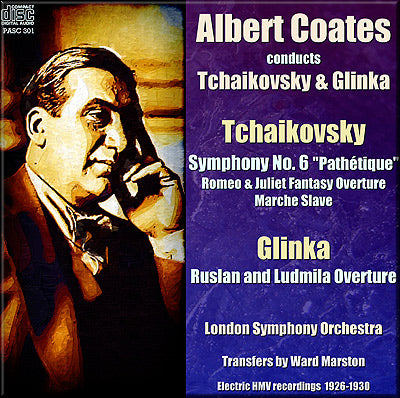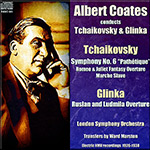
This album is included in the following sets:
This set contains the following albums:
- Producer's Note
- Full Track Listing
- Cover Art
Albert Coates: Tchaikovsky's Pathétique Symphony and more
"Fine transfers ensure that Coates’ message comes across loud and clear."
- MusicWeb International
The Pathetique symphony is transferred from quiet Italian pressings, the only set of quiet pressings I have ever seen - late 1930s Italian VDP pressings which yield far quieter surfaces than domestic HMV pressings. This recording has wonderfully ambient sonics but very little low frequency content, The reason being that the performance was transmitted over phone line from Kingsway Hall to Small Queen’s hall. I did what I could to boost the lower frequencies. One can hear that sides 2 and 5 were recorded under different conditions than the rest of the recording. One can also hear some low frequency electronic noises during the final side.
The Romeo and Juliet, with the Glinka filler, was only issued on Czech HMV. I have only seen 3 sets in 30 years and my set is the only one of the three that has no blasting on the loud passages. VDP numbers AW46-48 are listed in Alan Kelly's compilation files, but I have not heard of a copy in circulation. The March Slav is also very scarce.
Ward Marston
Issued on English HMV D1190-94, on VDP AW148-152, Gramola ES232-236, and Electrola EJ116-120
Matrices:
Movement I: CR665-2A, CR666-3, CR667-2, CR668-2.
Movement II: CR669-2A, CR670-1.
Movement III: CR671-1, CR672-1.
Movement IV: CR673-1A, CR674-1A
Recorded 11 October 1928
Issued on HMV ES481-3
matrices Cc20616-2 and Cc20617-1;
Recorded 11 October 1928
Issued on HMV ES481-3
Matrices: Cc13707-2, Cc13701-1, Cc13702-2, Cc13703-1, and Cc13704-1.
issued only on Czech HMV ES481-3.
VDP numbers AW46-48 are listed in Alan Kelly's compilation files, but I have not heard of a copy in circulation.
Recorded 17 October 1928
Issued on HMV ES483
Matrix Cc13723-2
All recordings: Kingsway Hall, London
London Symphony Orchestra
Albert Coates, conductor
MusicWeb International Review
Glowering, gloomy, colourful, exciting and passionate by turns – piece and performance
Albert Coates has always stimulated the interest of the
historically-minded collector. Naturally that is because his
performances are stamped with his unique personality – mainly volcanic,
and often the purveyor of sizzling accelerandi. But there is another
reason to seek out recordings by him, which is that some are very rare.
This may seem puzzling, given the wide currency many projects enjoyed on
HMV and its American affiliate. But it remains true for a small
percentage of his recordings and such is the case for all but the
Symphony in this release.
Some may well have acquainted
themselves with this Sixth, largely recorded in Kingsway Hall, London,
and transmitted down the phone line to the Small Queen’s Hall. The
lightness of bass frequencies has led Ward Marston to boost them
somewhat. The pressings are Italian HMVs, quieter than British ones.
The performance is commanding, charged and full of Coates’s typical
authentic-sounding control of the ebb and flow of the music’s syntax.
Its luscious elasticity burgeons splendidly in his hands, and the LSO
plays with distinction, if not always immaculate discipline – it hardly
bothered me when the voltage meter is set so high. The expressive power
led me to consider what the state of affairs might have been had Coates
been allowed to record Wagner operas in the late 30s, to supplement his
extensive but creaky sounding earlier performances.
HMV was
still using bass reinforcements at this time, despite the fact that this
was an electrical recording. Maybe the land line recording encouraged
them still further in the belief that a galumphing bass was needed, but
to our ears it most certainly isn’t. So the demerit of the second
movement is the huffing and puffing element engendered by the
unnecessary bass, whilst the plus is the often lovely and affectionate
string portamentos. Coates is typically in his element in this work, and
directs the finale with huge and communicative élan. If you listen
carefully you can hear the first movement side change following which a
later recording was used, not taken via landline. You can also hear the
perfectly appropriate side join at around 4:20 in the finale.
After the incendiary delights of Coates’ Sixth, we turn to the rarities. Marche Slave is jubilant and proto-Ivesian in its mesh of sounds. It’s a rare disc, recorded in October 1930. Romeo and Juliet
was recorded in October 1928. It’s glowering, gloomy, colourful,
exciting and passionate by turns – piece and performance. It was, for
some reason, only ever issued on Czech HMVs. Lucky them! The filler was
Glinka’s Ruslan and Ludmila overture – not as amazing as Mravinsky’s, but showing Coates in dynamic form once again.
Fine transfers ensure that Coates’ message comes across loud and clear.
Jonathan Woolf

